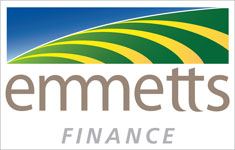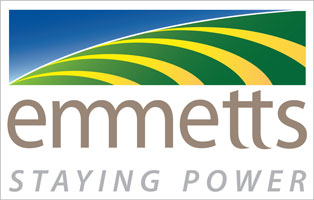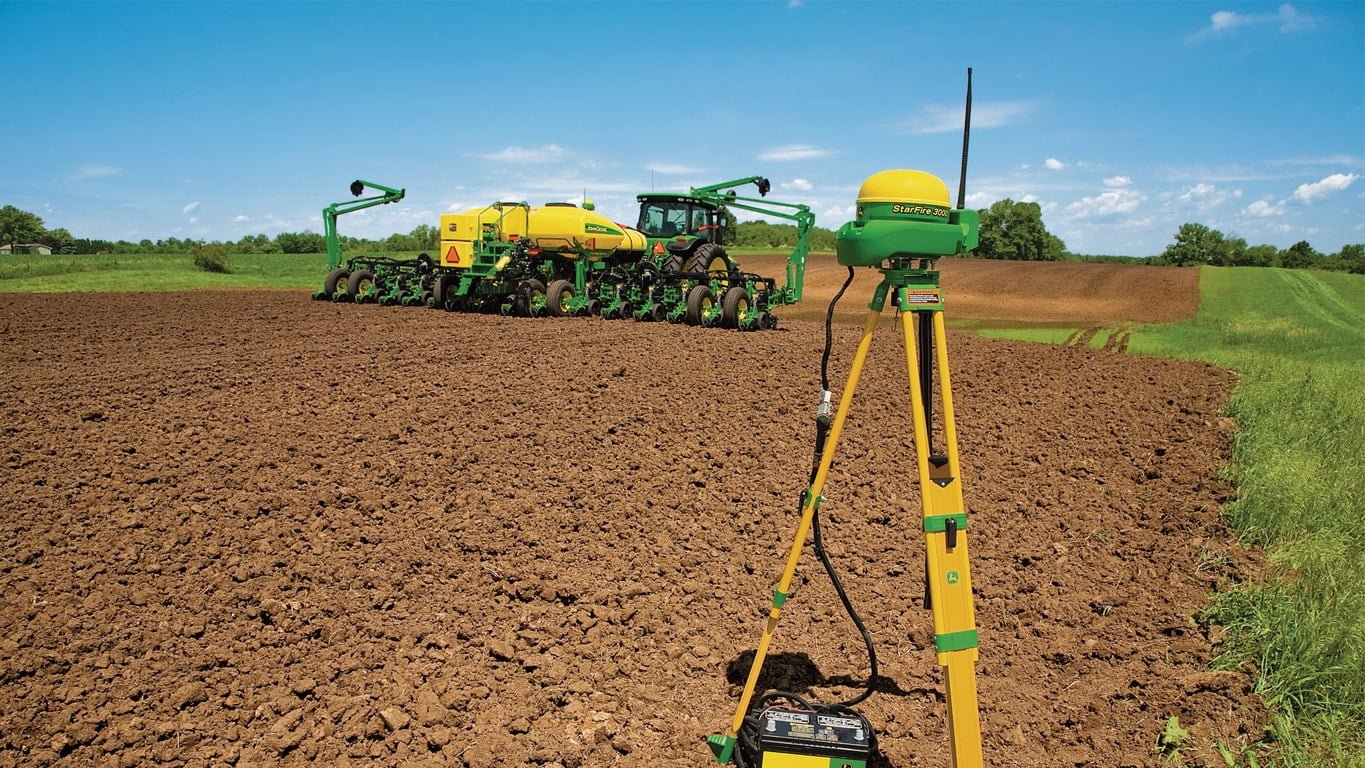
- Ideal for use in flat or rolling terrain
- Repeaters help maximise base station coverage
- Dealer-owned RTK network benefits producers
- Reduces overlap
Features
Broaden RTK availability with repeaters
 Repeater diagram with repeater (1) and RTK base station (2)
Repeater diagram with repeater (1) and RTK base station (2)
Broaden RTK availability with repeaters
RTK repeaters are radios that can be used to improve base station signal coverage around obstacles, such as trees or rolling terrain. The purpose of the RTK repeater is to receive the correction signal coming from the base station and then transmit that correction signal.
More than one repeater can be used with one base station, but the repeater cannot receive signal from each other in a daisy-chain configuration. In order to operate, a repeater must be connected to a 12-V power source.
A repeater is the same as the radio that is on a machine or base station receiver.
A repeater consists of the following:
- John Deere RTK Radio 450 or 900
- Power harness and bracket
Receive highly accurate, repeatable satellite correction with RTK
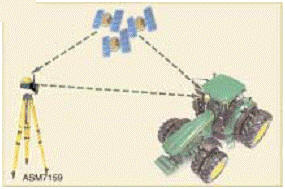 RTK is a local, ground-based reference station
RTK is a local, ground-based reference station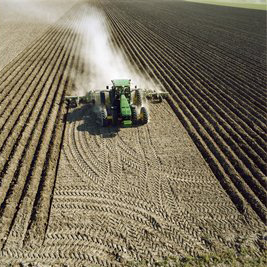 Planting requires precise accuracy
Planting requires precise accuracyRTK from John Deere provides highly accurate, repeatable corrections from global positioning system (GPS) to John Deere's suite of precision ag applications. RTK utilizes a local, ground-based reference station that transmits the high-accuracy corrections to a StarFire™ Receiver on a machine via RTK radios.
StarFire RTK accuracy depends on the distance between the base station and the machine. The shorter the distance, the more accurate the system will be. In general, the accuracy of StarFire RTK is described below.
- +/- 2.5 cm (1 in.) horizontal pass to pass, 95 percent of the time, 20 km (12 mile) baseline
- +/- 5.0 cm (2 in.) vertical pass to pass, 95 percent of the time, 2 km (1 mile) baseline
- Up to 20 km (12 miles) line of sight
- Measured at the receiver every 15 minutes
Dealer-owned RTK network benefits producers
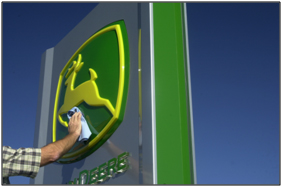 Dealers are critical to RTK network's success
Dealers are critical to RTK network's success
Dealers across Australia and New Zealand have set up a robust RTK network.
- Producers have a lower investment cost because the dealer purchases and is responsible for base station upkeep.
- Dealer networks cover more area with the RTK signal, giving many producers access to RTK on all of their grounds.
- RTK network is owned, maintained, and supported by a local, certified John Deere dealer.
Contact a local John Deere dealer to inquire about RTK network coverage.
RTK accuracy provides many benefits
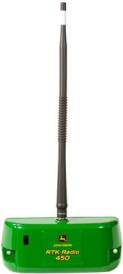 John Deere RTK Radio 450
John Deere RTK Radio 450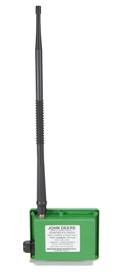 John Deere RTK Radio 900
John Deere RTK Radio 900RTK accuracy provides many benefits to the user as well as highly accurate corrections to a suite of John Deere precision solutions. Receivers utilizing this type of signal correction have repeatable +/- 2.5-cm (1-in.) horizontal pass-to-pass accuracy and +/- 5-cm (2-in.) vertical pass-to-pass accuracy.
Benefits include:
- Reduced overlap
A producer running RTK can operate at +/- 2.5-cm (1-in.) horizontal pass-to-pass accuracy. With less overlap, fewer inputs are used and overall costs can be reduced. - No satellite drift
Inherent to any satellite-based guidance system, drift occurs. Whether it is starting up a tractor in the morning or servicing it during the day, A-B lines can drift during those time periods. With RTK, satellite drift is completely taken out, because the stationary, local base station is now providing the corrections. - Additional functionality
RTK also enables other John Deere products to provide greater precision and repeatability like implement guidance.
Easily set up John Deere RTK Radio 900
 John Deere RTK Radio 900
John Deere RTK Radio 900
Base stations using John Deere RTK Radio 900 are very easy to set up for several reasons:
Licensing
The John Deere RTK Radio 900 operates in the 902-MHz to 928-MHz frequency range. This range does not require a license from the U.S. Federal Communications Commission (FCC), so the base station can be set up anywhere as long as it does not broadcast more than 4 W of power.
For more information on FCC regulations of the 902-MHz to 928-MHz range, visit www.fcc.gov or talk to a local John Deere dealer.
Mounting
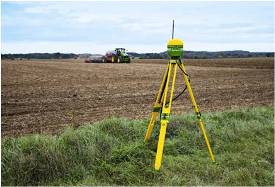 Mobile base station configuration
Mobile base station configuration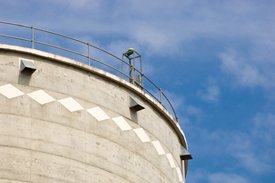 Permanent base station configuration
Permanent base station configurationA John Deere RTK Radio 900 base station can be used in a mobile setup or mounted permanently to a building, concrete silo, or radio tower. Depending on the operation, either type of mounting can be used:
- Mobile base station
- Fields are spread out and one base station cannot cover all of the ground
- For producers in areas with hilly terrain and lots of foliage where a permanent base station would not provide adequate coverage
- Situations where accuracy is needed, but not repeatability
- Permanent base station
- Producers in areas with flat terrain and little foliage where a permanent base station would provide adequate coverage in a large region
- Multiple tractors in different fields could use the same base station instead of purchasing a second one
- Situations where accuracy and repeatability are needed
Repeaters
 Repeater diagram with Repeater (1) and RTK Base Station (2)
Repeater diagram with Repeater (1) and RTK Base Station (2)
If a producer using RTK discovers a signal hole where the signal is lacking, a repeater radio can be easily set up to help fill the gap.
Keep running with RTK Extend™ system
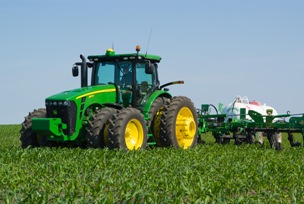 StarFire™ 3000 Receiver on 8R Tractor
StarFire™ 3000 Receiver on 8R Tractor
With many RTK solutions, automatic guidance simply stops working if trees or rolling terrain interfere with the line of sight between the base station and the machine. That is not the case when using RTK with John Deere, thanks to RTK Extend capability.
RTK Extend is an industry-exclusive feature of John Deere RTK. This allows AutoTrac™ steering system to keep functioning for up to 15 minutes with RTK accuracy without line of sight to the base station.
RTK and StarFire 3000 Receiver
When using StarFire 3000 Receivers, the machine receiver automatically goes to the SF2 signal when RTK Extend expires. This allows operators to take advantage +/- 5 cm (2 in.) horizontal pass-to-pass accuracy along tree lines or hilly terrain. The availability of SF2 provides RTK users with the best available accuracy by lessening the impact of any given field condition.
The machine will transition from RTK to RTK Extend, to SF2, and back to RTK without disengaging AutoTrac steering system.
NOTE: The base station must be powered on for at least one hour for RTK Extend to function.


